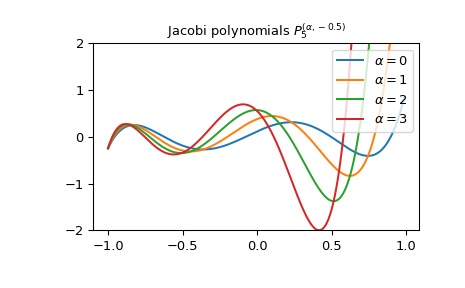jacobi#
- scipy.special.jacobi(n, alpha, beta, monic=False)[source]#
Jacobi polynomial.
Defined to be the solution of
\[(1 - x^2)\frac{d^2}{dx^2}P_n^{(\alpha, \beta)} + (\beta - \alpha - (\alpha + \beta + 2)x) \frac{d}{dx}P_n^{(\alpha, \beta)} + n(n + \alpha + \beta + 1)P_n^{(\alpha, \beta)} = 0\]for \(\alpha, \beta > -1\); \(P_n^{(\alpha, \beta)}\) is a polynomial of degree \(n\).
- Parameters:
- nint
Degree of the polynomial.
- alphafloat
Parameter, must be greater than -1.
- betafloat
Parameter, must be greater than -1.
- monicbool, optional
If True, scale the leading coefficient to be 1. Default is False.
- Returns:
- Porthopoly1d
Jacobi polynomial.
Notes
For fixed \(\alpha, \beta\), the polynomials \(P_n^{(\alpha, \beta)}\) are orthogonal over \([-1, 1]\) with weight function \((1 - x)^\alpha(1 + x)^\beta\).
References
[AS]Milton Abramowitz and Irene A. Stegun, eds. Handbook of Mathematical Functions with Formulas, Graphs, and Mathematical Tables. New York: Dover, 1972.
Examples
The Jacobi polynomials satisfy the recurrence relation:
\[P_n^{(\alpha, \beta-1)}(x) - P_n^{(\alpha-1, \beta)}(x) = P_{n-1}^{(\alpha, \beta)}(x)\]This can be verified, for example, for \(\alpha = \beta = 2\) and \(n = 1\) over the interval \([-1, 1]\):
>>> import numpy as np >>> from scipy.special import jacobi >>> x = np.arange(-1.0, 1.0, 0.01) >>> np.allclose(jacobi(0, 2, 2)(x), ... jacobi(1, 2, 1)(x) - jacobi(1, 1, 2)(x)) True
Plot of the Jacobi polynomial \(P_5^{(\alpha, -0.5)}\) for different values of \(\alpha\):
>>> import matplotlib.pyplot as plt >>> x = np.arange(-1.0, 1.0, 0.01) >>> fig, ax = plt.subplots() >>> ax.set_ylim(-2.0, 2.0) >>> ax.set_title(r'Jacobi polynomials $P_5^{(\alpha, -0.5)}$') >>> for alpha in np.arange(0, 4, 1): ... ax.plot(x, jacobi(5, alpha, -0.5)(x), label=rf'$\alpha={alpha}$') >>> plt.legend(loc='best') >>> plt.show()
